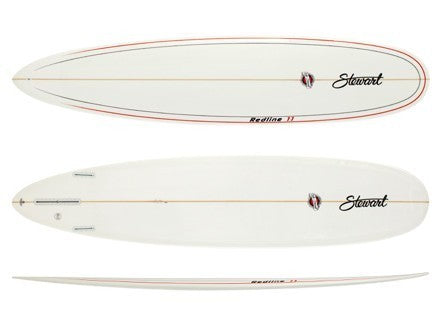Getting to Know Father of the Modern Longboard
Reinventing the Log
Getting to Know Bill Stewart, Father of the Modern Longboard
Bill Stewart is said to be the father of the modern longboard, but his influence started long before curves became cool again. In 1967, Stewart was repairing dings and experimenting with shorter surf craft as the Shortboard Revolution came into full swing. He’d cut down old longboards into shorter designs, then take what he’d learned and build on it the next time. By the time he invented the Hydro Hull he was already established as a household name in the California shaping game, having invented the two plus one setup and co-founded Future fins. But the Hydro was what took him international.
Stewart Redline11 the #1 Selling easy-riding longboard in the world
Stewart was a professional shortboard surfer and never understood why longboards went so slow and couldn’t be surfed aggressively. So he ended up adding a single to double concave to a longboard with a two-plus one setup, then beveled the entry rail to make them more forgiving, and voila! Suddenly guys were doing off-the-lips and airs and 360s on longboards. He now makes both traditional and progressive longboards and asserts that it’s all a matter of how you enjoy surfing. If you want to do drop-knee cutbacks, walk the nose with impeccable style, and hang 10 from takeoff to kick out, then he has the boards to support it. And if you want to surf like a short boarder, but have the freedom to perch on the tip as well, then his modern shapes are the go.
Stewart has made boards for progressive longboarders like multiple world champion Colin McPhillips, Jeff Krammer, Dale Dobson, and David Nuuhiwa, but surfboards haven’t been his only contribution to the surf community. He was an artist straight out of the cradle and learned airbrushing at the Art Institute of Fort Lauderdale Beach in 1971. He did live murals on MTV, was the second person to ever airbrush a surfboard, airbrushed 500 display boards for OP, and was voted best artist in Surfing Magazine.
Stewart Center Fin
Stewart has also been pivotal in designing effective, unique center fin designs for longboards. His center fin is more upright than the standard fin, with the rake at the top and the tip more rounded. This makes for a more forgiving fin, which is in keeping with the theory behind the Hydro Hull, which is to take a longboard and make it more maneuverable and user-friendly.
Today, Stewart is still considered one of the most important and informed longboard shapers, and operates the hugely successful Stewart Surfboards out of San Clemente, CA. When not in the shaping bay, Bill can be found surfing the waves in and around San Clemente, sneaking empty Lowers sessions and ripping Cottons. The impact he has had on surfing in general, and on the longboard scene in particular, cannot be understated.



